COIT20261 Network Routing and Switching: Assignment
VerifiedAdded on 2021/06/16
|7
|2235
|67
AI Summary
Contribute Materials
Your contribution can guide someone’s learning journey. Share your
documents today.
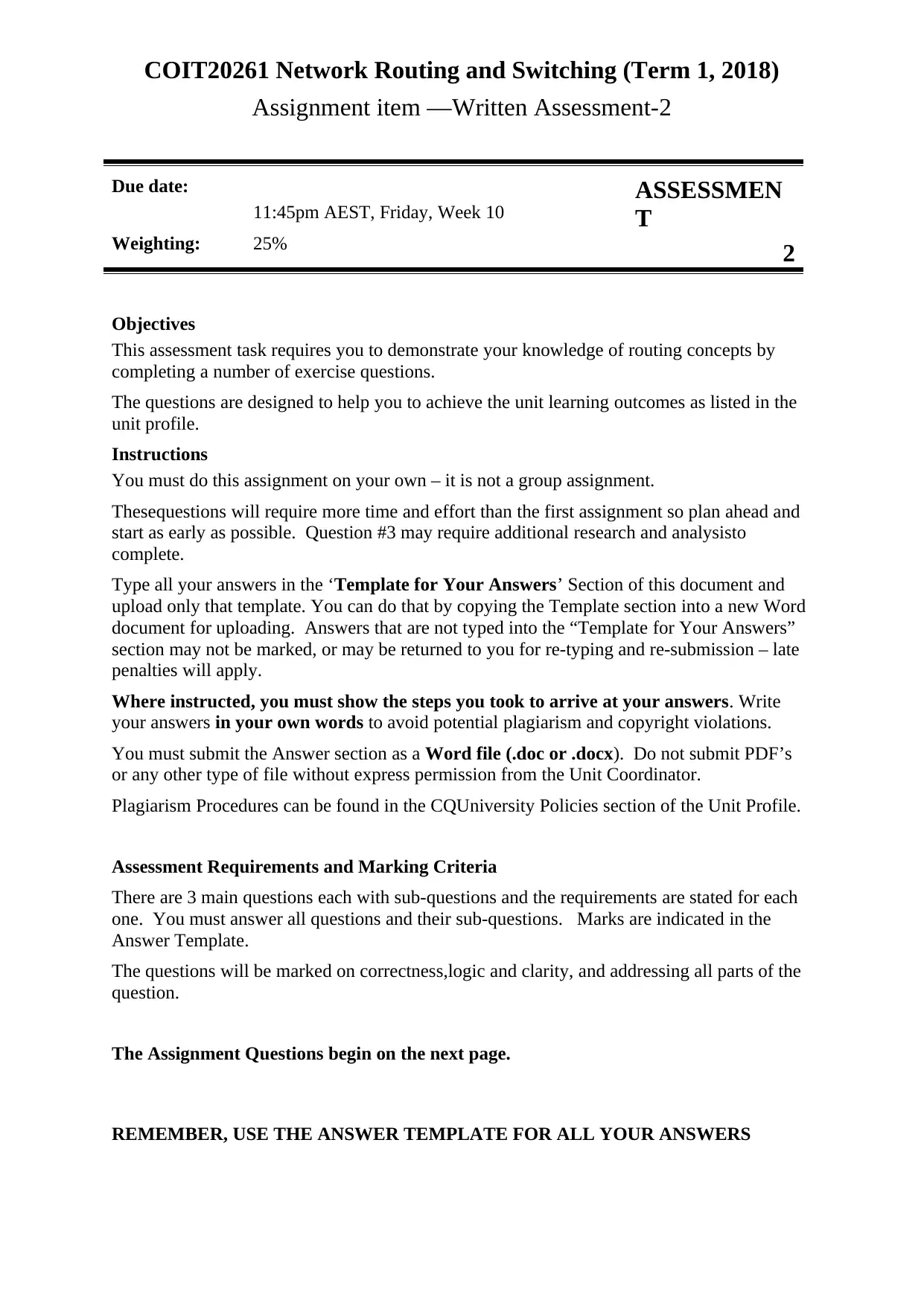
COIT20261 Network Routing and Switching (Term 1, 2018)
Assignment item —Written Assessment-2
Due date:
11:45pm AEST, Friday, Week 10
ASSESSMEN
T
Weighting: 25% 2
Objectives
This assessment task requires you to demonstrate your knowledge of routing concepts by
completing a number of exercise questions.
The questions are designed to help you to achieve the unit learning outcomes as listed in the
unit profile.
Instructions
You must do this assignment on your own – it is not a group assignment.
Thesequestions will require more time and effort than the first assignment so plan ahead and
start as early as possible. Question #3 may require additional research and analysisto
complete.
Type all your answers in the ‘Template for Your Answers’ Section of this document and
upload only that template. You can do that by copying the Template section into a new Word
document for uploading. Answers that are not typed into the “Template for Your Answers”
section may not be marked, or may be returned to you for re-typing and re-submission – late
penalties will apply.
Where instructed, you must show the steps you took to arrive at your answers. Write
your answers in your own words to avoid potential plagiarism and copyright violations.
You must submit the Answer section as a Word file (.doc or .docx). Do not submit PDF’s
or any other type of file without express permission from the Unit Coordinator.
Plagiarism Procedures can be found in the CQUniversity Policies section of the Unit Profile.
Assessment Requirements and Marking Criteria
There are 3 main questions each with sub-questions and the requirements are stated for each
one. You must answer all questions and their sub-questions. Marks are indicated in the
Answer Template.
The questions will be marked on correctness,logic and clarity, and addressing all parts of the
question.
The Assignment Questions begin on the next page.
REMEMBER, USE THE ANSWER TEMPLATE FOR ALL YOUR ANSWERS
Assignment item —Written Assessment-2
Due date:
11:45pm AEST, Friday, Week 10
ASSESSMEN
T
Weighting: 25% 2
Objectives
This assessment task requires you to demonstrate your knowledge of routing concepts by
completing a number of exercise questions.
The questions are designed to help you to achieve the unit learning outcomes as listed in the
unit profile.
Instructions
You must do this assignment on your own – it is not a group assignment.
Thesequestions will require more time and effort than the first assignment so plan ahead and
start as early as possible. Question #3 may require additional research and analysisto
complete.
Type all your answers in the ‘Template for Your Answers’ Section of this document and
upload only that template. You can do that by copying the Template section into a new Word
document for uploading. Answers that are not typed into the “Template for Your Answers”
section may not be marked, or may be returned to you for re-typing and re-submission – late
penalties will apply.
Where instructed, you must show the steps you took to arrive at your answers. Write
your answers in your own words to avoid potential plagiarism and copyright violations.
You must submit the Answer section as a Word file (.doc or .docx). Do not submit PDF’s
or any other type of file without express permission from the Unit Coordinator.
Plagiarism Procedures can be found in the CQUniversity Policies section of the Unit Profile.
Assessment Requirements and Marking Criteria
There are 3 main questions each with sub-questions and the requirements are stated for each
one. You must answer all questions and their sub-questions. Marks are indicated in the
Answer Template.
The questions will be marked on correctness,logic and clarity, and addressing all parts of the
question.
The Assignment Questions begin on the next page.
REMEMBER, USE THE ANSWER TEMPLATE FOR ALL YOUR ANSWERS
Secure Best Marks with AI Grader
Need help grading? Try our AI Grader for instant feedback on your assignments.
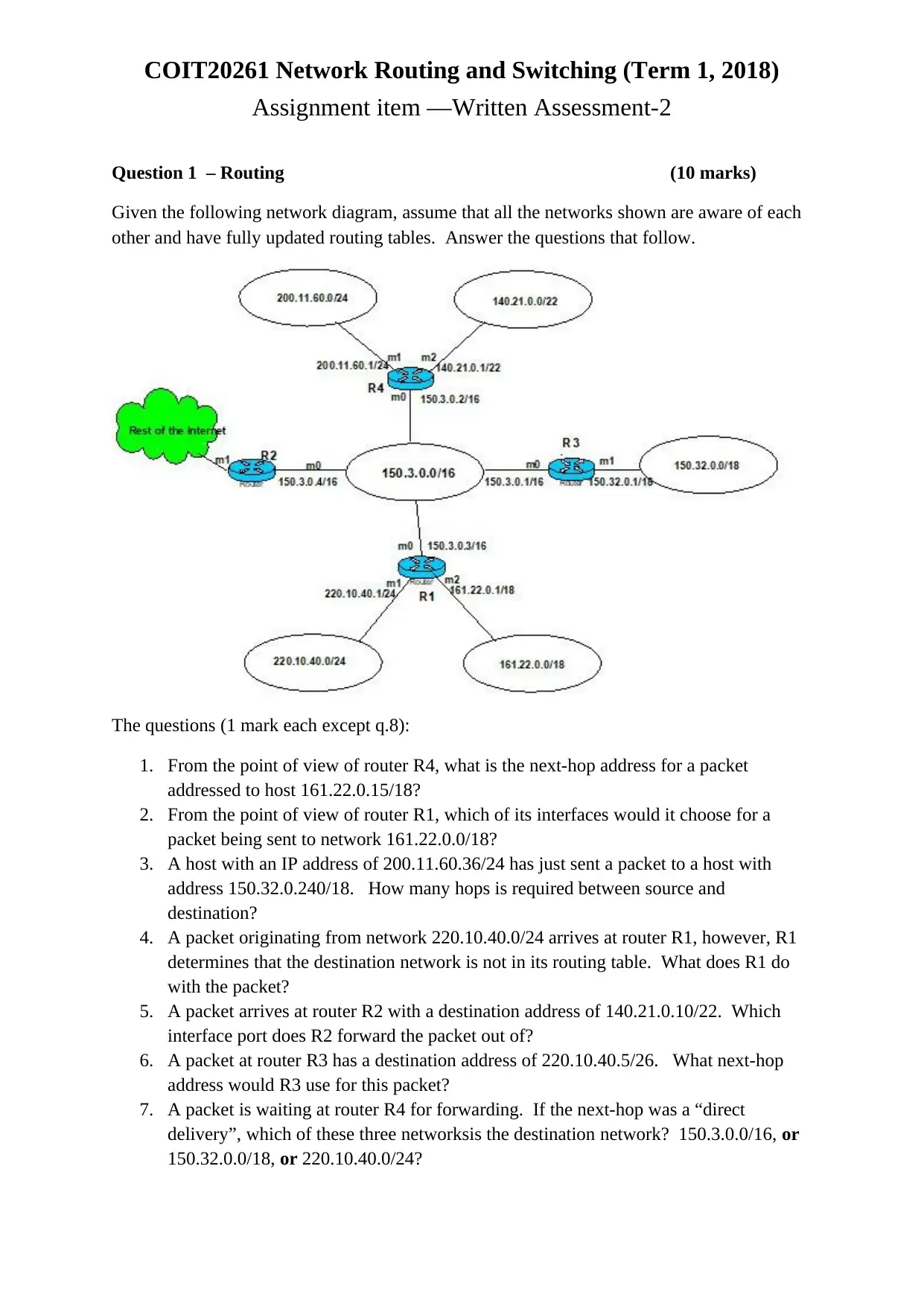
COIT20261 Network Routing and Switching (Term 1, 2018)
Assignment item —Written Assessment-2
Question 1 – Routing (10 marks)
Given the following network diagram, assume that all the networks shown are aware of each
other and have fully updated routing tables. Answer the questions that follow.
The questions (1 mark each except q.8):
1. From the point of view of router R4, what is the next-hop address for a packet
addressed to host 161.22.0.15/18?
2. From the point of view of router R1, which of its interfaces would it choose for a
packet being sent to network 161.22.0.0/18?
3. A host with an IP address of 200.11.60.36/24 has just sent a packet to a host with
address 150.32.0.240/18. How many hops is required between source and
destination?
4. A packet originating from network 220.10.40.0/24 arrives at router R1, however, R1
determines that the destination network is not in its routing table. What does R1 do
with the packet?
5. A packet arrives at router R2 with a destination address of 140.21.0.10/22. Which
interface port does R2 forward the packet out of?
6. A packet at router R3 has a destination address of 220.10.40.5/26. What next-hop
address would R3 use for this packet?
7. A packet is waiting at router R4 for forwarding. If the next-hop was a “direct
delivery”, which of these three networksis the destination network? 150.3.0.0/16, or
150.32.0.0/18, or 220.10.40.0/24?
Assignment item —Written Assessment-2
Question 1 – Routing (10 marks)
Given the following network diagram, assume that all the networks shown are aware of each
other and have fully updated routing tables. Answer the questions that follow.
The questions (1 mark each except q.8):
1. From the point of view of router R4, what is the next-hop address for a packet
addressed to host 161.22.0.15/18?
2. From the point of view of router R1, which of its interfaces would it choose for a
packet being sent to network 161.22.0.0/18?
3. A host with an IP address of 200.11.60.36/24 has just sent a packet to a host with
address 150.32.0.240/18. How many hops is required between source and
destination?
4. A packet originating from network 220.10.40.0/24 arrives at router R1, however, R1
determines that the destination network is not in its routing table. What does R1 do
with the packet?
5. A packet arrives at router R2 with a destination address of 140.21.0.10/22. Which
interface port does R2 forward the packet out of?
6. A packet at router R3 has a destination address of 220.10.40.5/26. What next-hop
address would R3 use for this packet?
7. A packet is waiting at router R4 for forwarding. If the next-hop was a “direct
delivery”, which of these three networksis the destination network? 150.3.0.0/16, or
150.32.0.0/18, or 220.10.40.0/24?
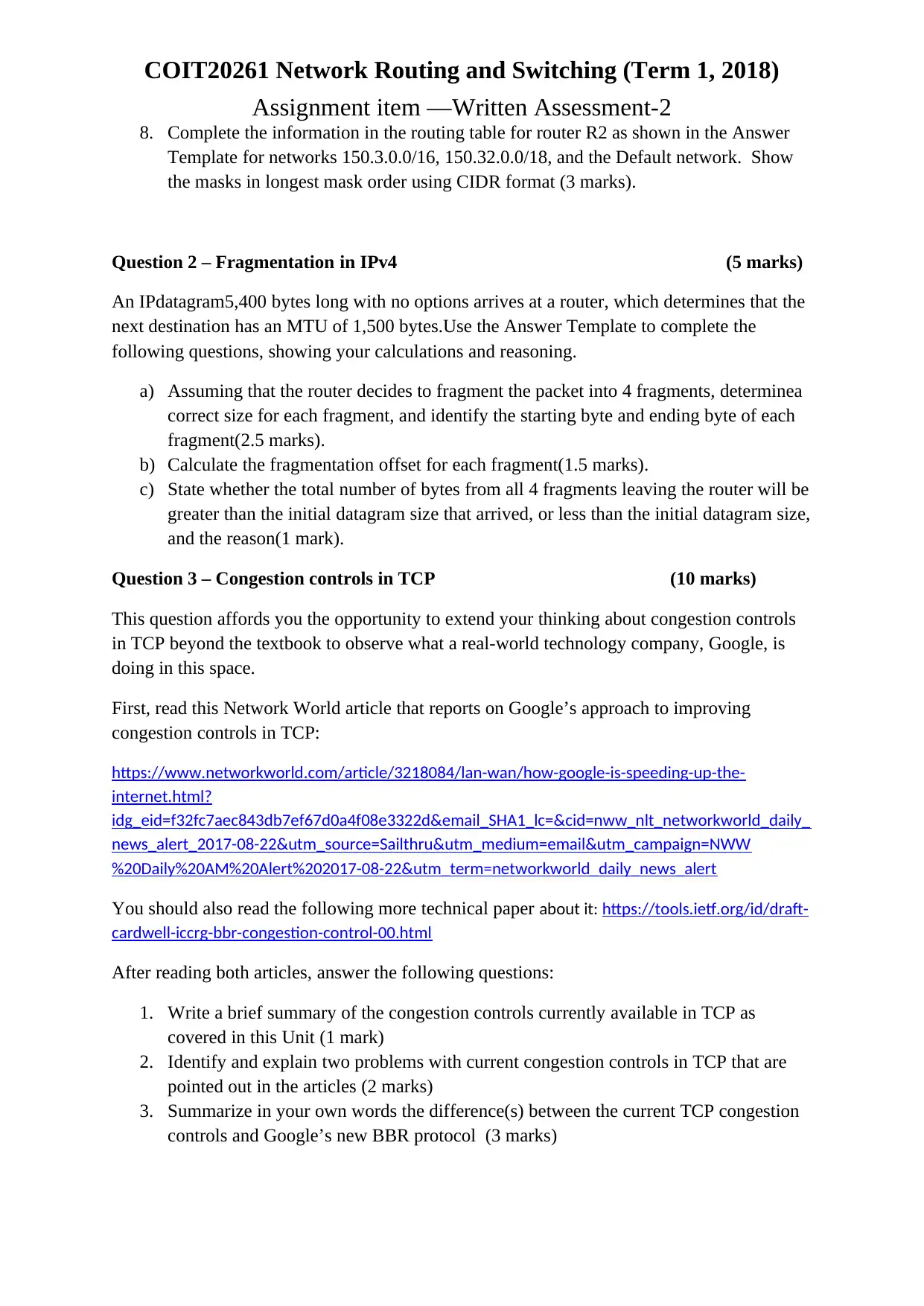
COIT20261 Network Routing and Switching (Term 1, 2018)
Assignment item —Written Assessment-2
8. Complete the information in the routing table for router R2 as shown in the Answer
Template for networks 150.3.0.0/16, 150.32.0.0/18, and the Default network. Show
the masks in longest mask order using CIDR format (3 marks).
Question 2 – Fragmentation in IPv4 (5 marks)
An IPdatagram5,400 bytes long with no options arrives at a router, which determines that the
next destination has an MTU of 1,500 bytes.Use the Answer Template to complete the
following questions, showing your calculations and reasoning.
a) Assuming that the router decides to fragment the packet into 4 fragments, determinea
correct size for each fragment, and identify the starting byte and ending byte of each
fragment(2.5 marks).
b) Calculate the fragmentation offset for each fragment(1.5 marks).
c) State whether the total number of bytes from all 4 fragments leaving the router will be
greater than the initial datagram size that arrived, or less than the initial datagram size,
and the reason(1 mark).
Question 3 – Congestion controls in TCP (10 marks)
This question affords you the opportunity to extend your thinking about congestion controls
in TCP beyond the textbook to observe what a real-world technology company, Google, is
doing in this space.
First, read this Network World article that reports on Google’s approach to improving
congestion controls in TCP:
https://www.networkworld.com/article/3218084/lan-wan/how-google-is-speeding-up-the-
internet.html?
idg_eid=f32fc7aec843db7ef67d0a4f08e3322d&email_SHA1_lc=&cid=nww_nlt_networkworld_daily_
news_alert_2017-08-22&utm_source=Sailthru&utm_medium=email&utm_campaign=NWW
%20Daily%20AM%20Alert%202017-08-22&utm_term=networkworld_daily_news_alert
You should also read the following more technical paper about it: https://tools.ietf.org/id/draft-
cardwell-iccrg-bbr-congestion-control-00.html
After reading both articles, answer the following questions:
1. Write a brief summary of the congestion controls currently available in TCP as
covered in this Unit (1 mark)
2. Identify and explain two problems with current congestion controls in TCP that are
pointed out in the articles (2 marks)
3. Summarize in your own words the difference(s) between the current TCP congestion
controls and Google’s new BBR protocol (3 marks)
Assignment item —Written Assessment-2
8. Complete the information in the routing table for router R2 as shown in the Answer
Template for networks 150.3.0.0/16, 150.32.0.0/18, and the Default network. Show
the masks in longest mask order using CIDR format (3 marks).
Question 2 – Fragmentation in IPv4 (5 marks)
An IPdatagram5,400 bytes long with no options arrives at a router, which determines that the
next destination has an MTU of 1,500 bytes.Use the Answer Template to complete the
following questions, showing your calculations and reasoning.
a) Assuming that the router decides to fragment the packet into 4 fragments, determinea
correct size for each fragment, and identify the starting byte and ending byte of each
fragment(2.5 marks).
b) Calculate the fragmentation offset for each fragment(1.5 marks).
c) State whether the total number of bytes from all 4 fragments leaving the router will be
greater than the initial datagram size that arrived, or less than the initial datagram size,
and the reason(1 mark).
Question 3 – Congestion controls in TCP (10 marks)
This question affords you the opportunity to extend your thinking about congestion controls
in TCP beyond the textbook to observe what a real-world technology company, Google, is
doing in this space.
First, read this Network World article that reports on Google’s approach to improving
congestion controls in TCP:
https://www.networkworld.com/article/3218084/lan-wan/how-google-is-speeding-up-the-
internet.html?
idg_eid=f32fc7aec843db7ef67d0a4f08e3322d&email_SHA1_lc=&cid=nww_nlt_networkworld_daily_
news_alert_2017-08-22&utm_source=Sailthru&utm_medium=email&utm_campaign=NWW
%20Daily%20AM%20Alert%202017-08-22&utm_term=networkworld_daily_news_alert
You should also read the following more technical paper about it: https://tools.ietf.org/id/draft-
cardwell-iccrg-bbr-congestion-control-00.html
After reading both articles, answer the following questions:
1. Write a brief summary of the congestion controls currently available in TCP as
covered in this Unit (1 mark)
2. Identify and explain two problems with current congestion controls in TCP that are
pointed out in the articles (2 marks)
3. Summarize in your own words the difference(s) between the current TCP congestion
controls and Google’s new BBR protocol (3 marks)

COIT20261 Network Routing and Switching (Term 1, 2018)
Assignment item —Written Assessment-2
4. The Network World article points out that it is difficult to get a new protocol accepted
as a global standard for TCP/IP. Why do you think this is the case? Give carefully
thought out reasons for your answer. (4 marks)
Important: for every direct quotation you use from these two sources or any other source, you
must immediately, after the quote, provideyourownexplanation of the quotation (for example,
explain why are you quoting it, how does it help answer the question, how does it support what you
are saying?) – marks will be deducted for failure to do so. In addition, correct referencing
conventions must be used throughout your work using the Harvard referencing convention. Your
answers will be marked on clarity, logic, relevance, use of own words and fully addressing all parts of
each question.
Remember that quotations alone will not be accepted as your explanation of the questions.
Quotations can support your explanations, but you must still provide the explanations yourself.
Best way forward is to keep direct quotations to a minimum, and use your own words.
Assignment item —Written Assessment-2
4. The Network World article points out that it is difficult to get a new protocol accepted
as a global standard for TCP/IP. Why do you think this is the case? Give carefully
thought out reasons for your answer. (4 marks)
Important: for every direct quotation you use from these two sources or any other source, you
must immediately, after the quote, provideyourownexplanation of the quotation (for example,
explain why are you quoting it, how does it help answer the question, how does it support what you
are saying?) – marks will be deducted for failure to do so. In addition, correct referencing
conventions must be used throughout your work using the Harvard referencing convention. Your
answers will be marked on clarity, logic, relevance, use of own words and fully addressing all parts of
each question.
Remember that quotations alone will not be accepted as your explanation of the questions.
Quotations can support your explanations, but you must still provide the explanations yourself.
Best way forward is to keep direct quotations to a minimum, and use your own words.
Secure Best Marks with AI Grader
Need help grading? Try our AI Grader for instant feedback on your assignments.
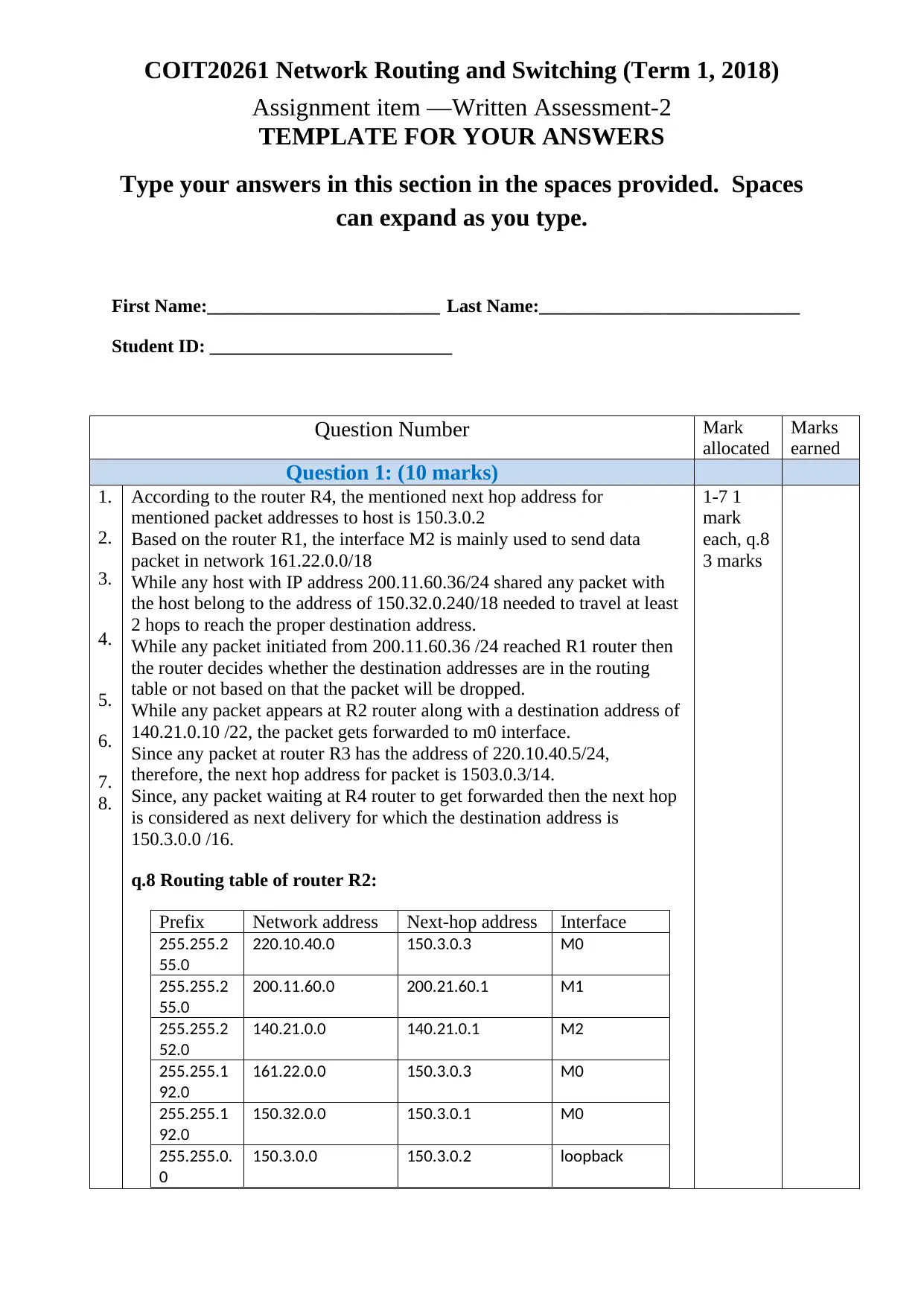
COIT20261 Network Routing and Switching (Term 1, 2018)
Assignment item —Written Assessment-2
TEMPLATE FOR YOUR ANSWERS
Type your answers in this section in the spaces provided. Spaces
can expand as you type.
First Name:_________________________ Last Name:____________________________
Student ID: __________________________
Question Number Mark
allocated
Marks
earned
Question 1: (10 marks)
1.
2.
3.
4.
5.
6.
7.
8.
According to the router R4, the mentioned next hop address for
mentioned packet addresses to host is 150.3.0.2
Based on the router R1, the interface M2 is mainly used to send data
packet in network 161.22.0.0/18
While any host with IP address 200.11.60.36/24 shared any packet with
the host belong to the address of 150.32.0.240/18 needed to travel at least
2 hops to reach the proper destination address.
While any packet initiated from 200.11.60.36 /24 reached R1 router then
the router decides whether the destination addresses are in the routing
table or not based on that the packet will be dropped.
While any packet appears at R2 router along with a destination address of
140.21.0.10 /22, the packet gets forwarded to m0 interface.
Since any packet at router R3 has the address of 220.10.40.5/24,
therefore, the next hop address for packet is 1503.0.3/14.
Since, any packet waiting at R4 router to get forwarded then the next hop
is considered as next delivery for which the destination address is
150.3.0.0 /16.
q.8 Routing table of router R2:
Prefix Network address Next-hop address Interface
255.255.2
55.0
220.10.40.0 150.3.0.3 M0
255.255.2
55.0
200.11.60.0 200.21.60.1 M1
255.255.2
52.0
140.21.0.0 140.21.0.1 M2
255.255.1
92.0
161.22.0.0 150.3.0.3 M0
255.255.1
92.0
150.32.0.0 150.3.0.1 M0
255.255.0.
0
150.3.0.0 150.3.0.2 loopback
1-7 1
mark
each, q.8
3 marks
Assignment item —Written Assessment-2
TEMPLATE FOR YOUR ANSWERS
Type your answers in this section in the spaces provided. Spaces
can expand as you type.
First Name:_________________________ Last Name:____________________________
Student ID: __________________________
Question Number Mark
allocated
Marks
earned
Question 1: (10 marks)
1.
2.
3.
4.
5.
6.
7.
8.
According to the router R4, the mentioned next hop address for
mentioned packet addresses to host is 150.3.0.2
Based on the router R1, the interface M2 is mainly used to send data
packet in network 161.22.0.0/18
While any host with IP address 200.11.60.36/24 shared any packet with
the host belong to the address of 150.32.0.240/18 needed to travel at least
2 hops to reach the proper destination address.
While any packet initiated from 200.11.60.36 /24 reached R1 router then
the router decides whether the destination addresses are in the routing
table or not based on that the packet will be dropped.
While any packet appears at R2 router along with a destination address of
140.21.0.10 /22, the packet gets forwarded to m0 interface.
Since any packet at router R3 has the address of 220.10.40.5/24,
therefore, the next hop address for packet is 1503.0.3/14.
Since, any packet waiting at R4 router to get forwarded then the next hop
is considered as next delivery for which the destination address is
150.3.0.0 /16.
q.8 Routing table of router R2:
Prefix Network address Next-hop address Interface
255.255.2
55.0
220.10.40.0 150.3.0.3 M0
255.255.2
55.0
200.11.60.0 200.21.60.1 M1
255.255.2
52.0
140.21.0.0 140.21.0.1 M2
255.255.1
92.0
161.22.0.0 150.3.0.3 M0
255.255.1
92.0
150.32.0.0 150.3.0.1 M0
255.255.0.
0
150.3.0.0 150.3.0.2 loopback
1-7 1
mark
each, q.8
3 marks
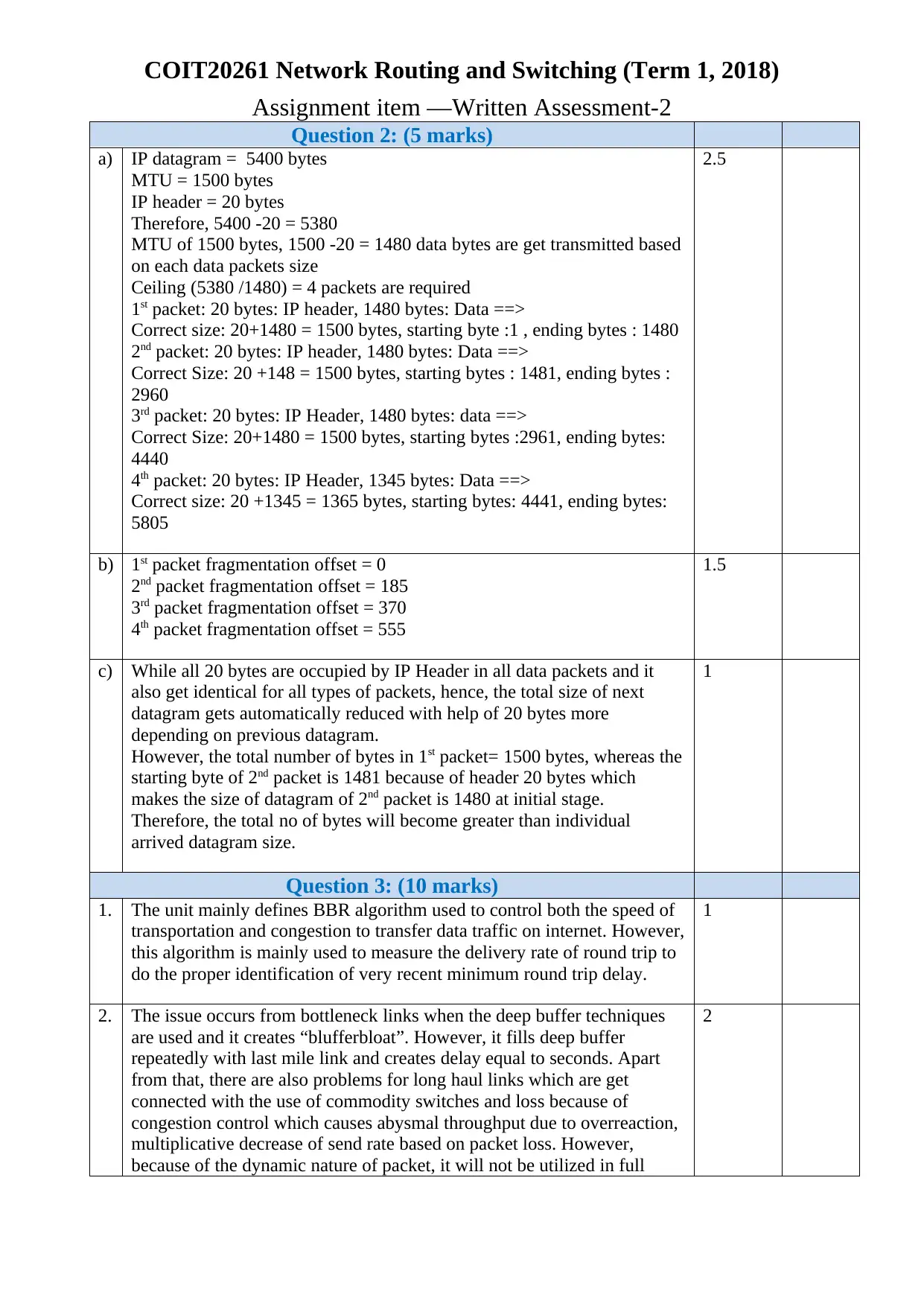
COIT20261 Network Routing and Switching (Term 1, 2018)
Assignment item —Written Assessment-2
Question 2: (5 marks)
a) IP datagram = 5400 bytes
MTU = 1500 bytes
IP header = 20 bytes
Therefore, 5400 -20 = 5380
MTU of 1500 bytes, 1500 -20 = 1480 data bytes are get transmitted based
on each data packets size
Ceiling (5380 /1480) = 4 packets are required
1st packet: 20 bytes: IP header, 1480 bytes: Data ==>
Correct size: 20+1480 = 1500 bytes, starting byte :1 , ending bytes : 1480
2nd packet: 20 bytes: IP header, 1480 bytes: Data ==>
Correct Size: 20 +148 = 1500 bytes, starting bytes : 1481, ending bytes :
2960
3rd packet: 20 bytes: IP Header, 1480 bytes: data ==>
Correct Size: 20+1480 = 1500 bytes, starting bytes :2961, ending bytes:
4440
4th packet: 20 bytes: IP Header, 1345 bytes: Data ==>
Correct size: 20 +1345 = 1365 bytes, starting bytes: 4441, ending bytes:
5805
2.5
b) 1st packet fragmentation offset = 0
2nd packet fragmentation offset = 185
3rd packet fragmentation offset = 370
4th packet fragmentation offset = 555
1.5
c) While all 20 bytes are occupied by IP Header in all data packets and it
also get identical for all types of packets, hence, the total size of next
datagram gets automatically reduced with help of 20 bytes more
depending on previous datagram.
However, the total number of bytes in 1st packet= 1500 bytes, whereas the
starting byte of 2nd packet is 1481 because of header 20 bytes which
makes the size of datagram of 2nd packet is 1480 at initial stage.
Therefore, the total no of bytes will become greater than individual
arrived datagram size.
1
Question 3: (10 marks)
1. The unit mainly defines BBR algorithm used to control both the speed of
transportation and congestion to transfer data traffic on internet. However,
this algorithm is mainly used to measure the delivery rate of round trip to
do the proper identification of very recent minimum round trip delay.
1
2. The issue occurs from bottleneck links when the deep buffer techniques
are used and it creates “blufferbloat”. However, it fills deep buffer
repeatedly with last mile link and creates delay equal to seconds. Apart
from that, there are also problems for long haul links which are get
connected with the use of commodity switches and loss because of
congestion control which causes abysmal throughput due to overreaction,
multiplicative decrease of send rate based on packet loss. However,
because of the dynamic nature of packet, it will not be utilized in full
2
Assignment item —Written Assessment-2
Question 2: (5 marks)
a) IP datagram = 5400 bytes
MTU = 1500 bytes
IP header = 20 bytes
Therefore, 5400 -20 = 5380
MTU of 1500 bytes, 1500 -20 = 1480 data bytes are get transmitted based
on each data packets size
Ceiling (5380 /1480) = 4 packets are required
1st packet: 20 bytes: IP header, 1480 bytes: Data ==>
Correct size: 20+1480 = 1500 bytes, starting byte :1 , ending bytes : 1480
2nd packet: 20 bytes: IP header, 1480 bytes: Data ==>
Correct Size: 20 +148 = 1500 bytes, starting bytes : 1481, ending bytes :
2960
3rd packet: 20 bytes: IP Header, 1480 bytes: data ==>
Correct Size: 20+1480 = 1500 bytes, starting bytes :2961, ending bytes:
4440
4th packet: 20 bytes: IP Header, 1345 bytes: Data ==>
Correct size: 20 +1345 = 1365 bytes, starting bytes: 4441, ending bytes:
5805
2.5
b) 1st packet fragmentation offset = 0
2nd packet fragmentation offset = 185
3rd packet fragmentation offset = 370
4th packet fragmentation offset = 555
1.5
c) While all 20 bytes are occupied by IP Header in all data packets and it
also get identical for all types of packets, hence, the total size of next
datagram gets automatically reduced with help of 20 bytes more
depending on previous datagram.
However, the total number of bytes in 1st packet= 1500 bytes, whereas the
starting byte of 2nd packet is 1481 because of header 20 bytes which
makes the size of datagram of 2nd packet is 1480 at initial stage.
Therefore, the total no of bytes will become greater than individual
arrived datagram size.
1
Question 3: (10 marks)
1. The unit mainly defines BBR algorithm used to control both the speed of
transportation and congestion to transfer data traffic on internet. However,
this algorithm is mainly used to measure the delivery rate of round trip to
do the proper identification of very recent minimum round trip delay.
1
2. The issue occurs from bottleneck links when the deep buffer techniques
are used and it creates “blufferbloat”. However, it fills deep buffer
repeatedly with last mile link and creates delay equal to seconds. Apart
from that, there are also problems for long haul links which are get
connected with the use of commodity switches and loss because of
congestion control which causes abysmal throughput due to overreaction,
multiplicative decrease of send rate based on packet loss. However,
because of the dynamic nature of packet, it will not be utilized in full
2
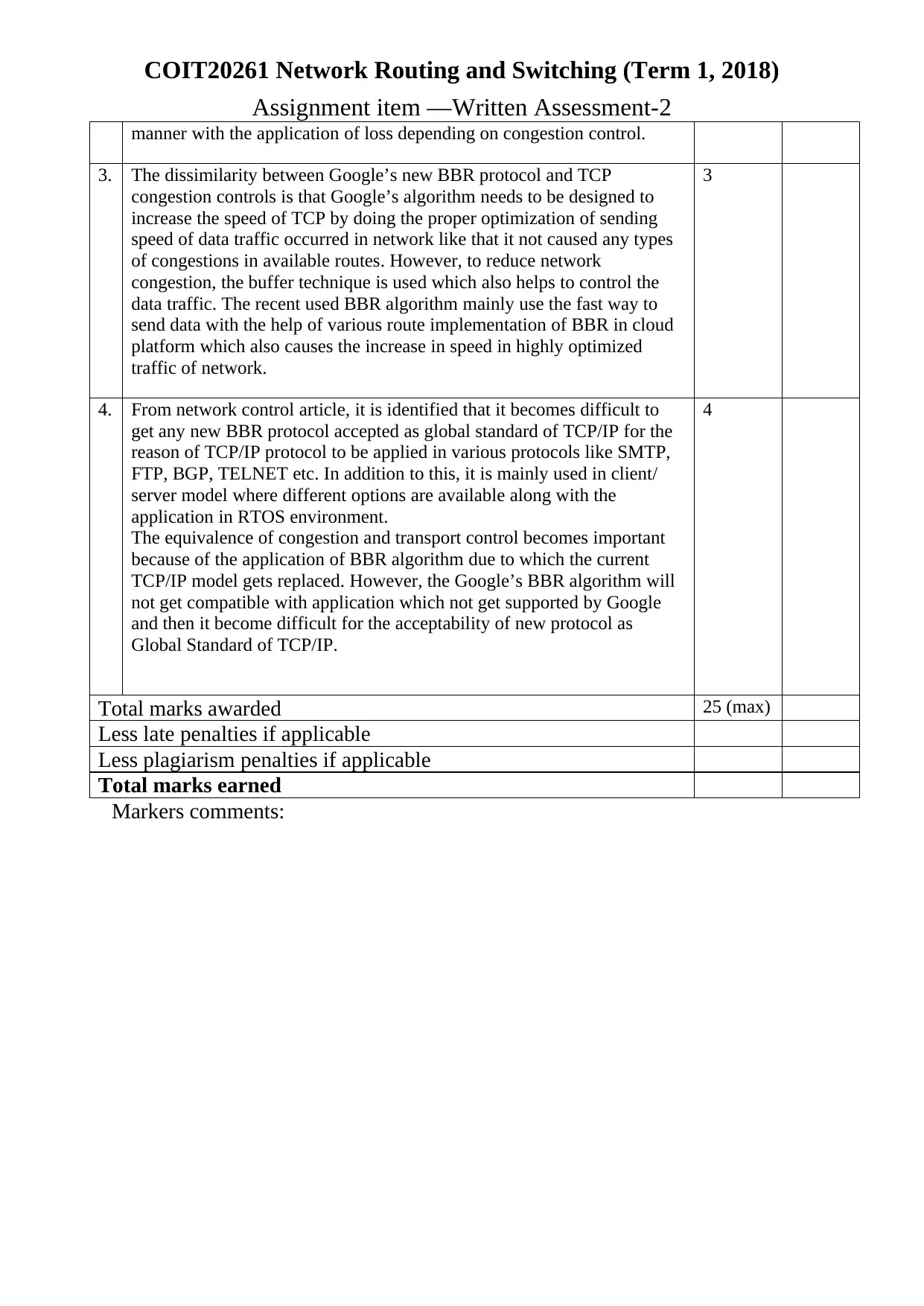
COIT20261 Network Routing and Switching (Term 1, 2018)
Assignment item —Written Assessment-2
manner with the application of loss depending on congestion control.
3. The dissimilarity between Google’s new BBR protocol and TCP
congestion controls is that Google’s algorithm needs to be designed to
increase the speed of TCP by doing the proper optimization of sending
speed of data traffic occurred in network like that it not caused any types
of congestions in available routes. However, to reduce network
congestion, the buffer technique is used which also helps to control the
data traffic. The recent used BBR algorithm mainly use the fast way to
send data with the help of various route implementation of BBR in cloud
platform which also causes the increase in speed in highly optimized
traffic of network.
3
4. From network control article, it is identified that it becomes difficult to
get any new BBR protocol accepted as global standard of TCP/IP for the
reason of TCP/IP protocol to be applied in various protocols like SMTP,
FTP, BGP, TELNET etc. In addition to this, it is mainly used in client/
server model where different options are available along with the
application in RTOS environment.
The equivalence of congestion and transport control becomes important
because of the application of BBR algorithm due to which the current
TCP/IP model gets replaced. However, the Google’s BBR algorithm will
not get compatible with application which not get supported by Google
and then it become difficult for the acceptability of new protocol as
Global Standard of TCP/IP.
4
Total marks awarded 25 (max)
Less late penalties if applicable
Less plagiarism penalties if applicable
Total marks earned
Markers comments:
Assignment item —Written Assessment-2
manner with the application of loss depending on congestion control.
3. The dissimilarity between Google’s new BBR protocol and TCP
congestion controls is that Google’s algorithm needs to be designed to
increase the speed of TCP by doing the proper optimization of sending
speed of data traffic occurred in network like that it not caused any types
of congestions in available routes. However, to reduce network
congestion, the buffer technique is used which also helps to control the
data traffic. The recent used BBR algorithm mainly use the fast way to
send data with the help of various route implementation of BBR in cloud
platform which also causes the increase in speed in highly optimized
traffic of network.
3
4. From network control article, it is identified that it becomes difficult to
get any new BBR protocol accepted as global standard of TCP/IP for the
reason of TCP/IP protocol to be applied in various protocols like SMTP,
FTP, BGP, TELNET etc. In addition to this, it is mainly used in client/
server model where different options are available along with the
application in RTOS environment.
The equivalence of congestion and transport control becomes important
because of the application of BBR algorithm due to which the current
TCP/IP model gets replaced. However, the Google’s BBR algorithm will
not get compatible with application which not get supported by Google
and then it become difficult for the acceptability of new protocol as
Global Standard of TCP/IP.
4
Total marks awarded 25 (max)
Less late penalties if applicable
Less plagiarism penalties if applicable
Total marks earned
Markers comments:
1 out of 7
Related Documents
Your All-in-One AI-Powered Toolkit for Academic Success.
+13062052269
info@desklib.com
Available 24*7 on WhatsApp / Email
![[object Object]](/_next/static/media/star-bottom.7253800d.svg)
Unlock your academic potential
© 2024 | Zucol Services PVT LTD | All rights reserved.





